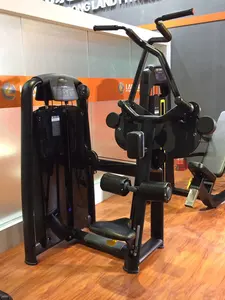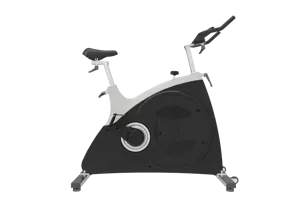(5858 products available)



















































































































































































































An indoor trainer bike is also known as a stationary bike. It is used for indoor cycling and exercise. It is available in different types that cater to various fitness needs and preferences. Here are some common types:
Indoor trainer bikes are versatile exercise equipment that can be used in various scenarios and situations. Here are some of them:
Home Workouts
Indoor trainer bikes are primarily used to exercise at home. They provide a convenient and effective way to stay fit without having to go to a gym or deal with external weather conditions. With the trainer bike, users can enjoy a range of cycling workouts, including steady-state rides, interval training, and even simulated outdoor rides, all within the comfort of their homes. Additionally, the bikes' compact design allows them to fit into various spaces, making them ideal for apartments or smaller spaces.
Rehabilitation and Physical Therapy
Indoor trainer bikes are also useful in rehabilitation and physical therapy programs. They provide low-impact cardiovascular exercise that can help patients recover strength, endurance, and mobility after an injury or surgery. The adjustable resistance levels on the trainer bike allow for a gradual increase in intensity, making it a safe and controlled environment for patients to rebuild their confidence and physical abilities. Moreover, cycling on a trainer bike puts less strain on joints, reducing the risk of pain or further injury during the recovery process.
Winter Training
Indoor trainer bikes are essential for cyclists and athletes who want to maintain their fitness and training levels during the winter months when outdoor riding may be challenging or impossible. Winter conditions can pose safety risks, making outdoor cycling difficult or dangerous; hence, indoor trainer bikes provide an alternative. Cyclists can replicate their regular outdoor routes and training sessions on the trainer bike, ensuring consistency in their training regimen. Additionally, trainer bikes are great for interval training, allowing cyclists to push themselves and improve their speed and endurance.
Multitasking
Indoor trainer bikes offer the flexibility to multitask during workouts. Users can watch TV, read, or catch up on work while exercising, making it easier to incorporate physical activity into their busy schedules. This makes the trainer bike an excellent option for those who struggle to find time to work out or get easily bored during traditional exercise routines. Moreover, the interactive features on some trainer bikes allow users to participate in virtual cycling classes or connect with other cyclists worldwide, providing motivation and a sense of community while working out at home.
Here are some factors buyers should consider when buying indoor trainer bikes for resale:
Noise level
Noise level is an important factor to consider when buying an indoor bike trainer. Cyclists often use the bike trainer in their homes. If the trainer is noisy, it will disturb the cyclist and other people living in the house. Some indoor bike trainers are equipped with noise-reducing technology. Cyclists can use them to enjoy a quiet and smooth workout session. The quietness of the indoor bike trainer is measured in decibels (dB). An indoor bike trainer with a low dB level is quieter.
Type of trainer
Indoor bike trainers come in different types, such as magnetic, wheel-on, smart, direct drive, and fluid trainers. Each type has its own benefits. For example, direct drive bike trainers offer a quiet workout experience. Smart bike trainers provide an interactive training experience. As a result, buyers should choose the most suitable type of indoor bike trainer for their customers’ needs.
Connectivity
Buyers should get indoor bike trainers that offer various connectivity options. The bike trainers need to have Bluetooth and WiFi connectivity options. These options allow the cyclists to connect with other devices like smartphones, tablets, and laptops. Proper connectivity options enable cyclists to access different training programs and compete with other cyclists.
Resistance level
Resistance level is another important factor to consider when choosing an indoor bike trainer. Resistance level determines how hard the workout will be. Buyers should look for indoor bike trainers with adjustable resistance levels. This will help cyclists customize their workout intensity to meet their fitness goals. Some indoor bike trainers are equipped with automatic resistance level settings. The features set the workout intensity automatically based on the cyclists’ performance.
Compatibility
Before buying indoor bike trainers, buyers should consider compatibility. Cyclists use different bike models. Some cyclists use mountain bikes, while others use road bikes. Buyers should get indoor bike trainers that are compatible with different bike models. This will ensure that indoor bike trainers can be used by different cyclists.
Budget
Indoor bike trainers come at various costs depending on the type, features, and brand. As mentioned earlier, indoor bike trainers come in different types. Some types of indoor bike trainers are more expensive than others. For example, a smart bike trainer is more expensive than a magnetic bike trainer. At the same time, it offers more features. Buyers should set a budget and get indoor bike trainers within the budget that are effective and durable.
Indoor trainer bikes come with various designs, features, and functions to suit different users' needs and preferences. Here are some common functions, features, and design elements associated with indoor trainer bikes:
Noise Reduction Technology
Manufacturers of indoor trainer bikes know that users would prefer a quieter bike. Therefore, they use noise reduction technology as a feature. This technology aims to minimize noise during cycling. It includes rubber mats, sound dampening materials, and noise-isolating frames. The noise reduction technology creates a more pleasant and focused workout environment.
Smart Connectivity
Smart connectivity is a common feature of modern indoor trainer bikes. With smart connectivity, the bikes can connect to various devices like tablets, smartphones, and computers. This allows the bikes to access interactive training programs and virtual cycling experiences. Through Wi-Fi and Bluetooth connections, users can participate in engaging and competitive workouts.
Personalized Settings
Indoor trainer bikes also come with personalized settings as a feature. These settings allow users to customize their workout experience. Users can adjust the bike settings and resistance levels to match their fitness goals and preferences. This feature ensures that each workout is tailored to the user's needs.
Space-Saving Design
Most indoor trainer bikes often have a space-saving design, particularly foldable models. These bikes have adjustable handlebars and seats, which are necessary for achieving the user's comfortable riding position. Additionally, the bikes have a foldable design, which allows for easy storage and portability. This space-saving design makes them ideal for small spaces.
Durable Build Quality
Indoor trainer bikes are designed for regular use, so they feature durable build quality. They are constructed from high-quality materials such as steel or aluminum alloys. This ensures longevity and stability during intense workouts. A durable build quality also enhances safety and minimizes maintenance needs.
Adjustable Resistance Levels
Adjustable resistance levels are a basic feature of indoor trainer bikes. They provide different resistance levels for users to choose from, which makes for an excellent workout. The resistance is either adjustable manually or electronically. This feature allows users to simulate various terrains and intensify their workouts, which improves cardiovascular health and strengthens muscles.
Ergonomic Design
Indoor trainer bikes often feature ergonomic design elements as a feature. These elements include cushioned seats, adjustable handlebars, and grips. They are designed to provide comfort and proper support during cycling. An ergonomic design reduces the risk of injury and discomfort, allowing users to have longer and more effective workouts.
Q: What does a trainer do for a bike?
A: A trainer is a device that makes it possible for a stationary bike to simulate riding on a real road. The trainer can be an indoor bike trainer or a spinning bike. It provides resistance, allowing the cyclist to have a workout indoors. When the bike's rear wheel is mounted on the trainer, it stays stationary while the tire rotates. Trainers can be smart or manual. Smart trainers connect to apps like Zwift to provide an interactive workout, while manual trainers have settings that can be adjusted manually.
Q: What is the difference between a stationary bike and a trainer?
A: A stationary bike and a trainer serve similar purposes but differ in their functionality. A stationary bike has a fixed rear wheel that cannot be moved, while a trainer requires the bike's rear wheel to be mounted on it. Riding on a stationary bike is like riding with no resistance on a stationary bike, while a trainer simulates real road resistance. A trainer can also provide different types of workouts, such as cycling through various terrains or even climbing hills. Trainers and stationary bikes are great for indoor cycling workouts.
Q: Can any bike be used with a trainer?
A: Not all bikes can be used with a trainer. But most bikes can be used with trainers. The compatibility of a bike with a trainer depends on the type of trainer. Manual trainers can be used with almost all bikes. Smart trainers require the bike to have a compatible axle. Hometrainers can be used with road bikes, mountain bikes, and fixed-gear bikes.
Q: How do I know if my bike is compatible with the trainer?
A: Check the compatibility of the bike with the trainer before purchasing it. The information is usually provided in the product description or manual. If not, contact customer service for assistance. Knowing whether the bike is compatible with the trainer is important because incompatible bikes can damage the trainer or the bike.
The web search volume for the keyword "indoor trainer bike" has shown significant fluctuations over the past year, with an average monthly web search volume of 6600. Notably, there has been a 23% increase in web searches both over the last three months and over the past year. The detailed monthly data reveals peaks in December, January, and February, each hitting 9900 web searches, followed by a gradual decline until the volume picks up again in October to 8100 web searches.
Analyzing the trend, the keyword experienced its highest web search volumes during the winter months, which then decreased as the seasons shifted towards spring and summer. This pattern suggests a seasonal influence, where interest in indoor training bikes spikes during colder months when outdoor cycling becomes less appealing or less feasible. The web search volume begins to recover in the fall, indicating a possible preparation period for cyclists looking to maintain fitness levels before the winter indoor training cycle begins anew.
The data clearly illustrates the dependency of this keyword's web search volume on seasonal changes, reflecting user behavior related to weather conditions and fitness routines. As winter approaches, more individuals are inclined to search for indoor training solutions, highlighting a direct correlation between seasonality and search trends in the sports category.